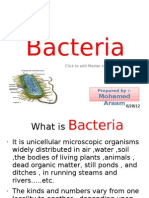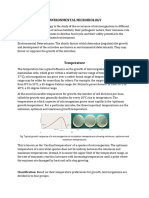Bacterial Growth
Bacterial Growth
Uploaded by
Iqra NoorCopyright:
Available Formats
Bacterial Growth
Bacterial Growth
Uploaded by
Iqra NoorOriginal Title
Copyright
Available Formats
Share this document
Did you find this document useful?
Is this content inappropriate?
Copyright:
Available Formats
Bacterial Growth
Bacterial Growth
Uploaded by
Iqra NoorCopyright:
Available Formats
Measurement of Bacterial Growth
1. Direct Microscopic Count
2. Determination of Turbidity
3. Viable Cell Count / Colony Counting
Page 1 of 5
Indirect Methods- Plate Count Dilute the sample and plate a known volume; incubate count the number of colonies 1 colony = 1 cell Calculate cells/ml adjusting for dilution
Advantages/disadvantages Direct count and turbidimetry may count dead cells Viable cell count do not Environmental Factors That Affect Growth
Page 2 of 5
Temperature pH Oxygen Carbon Dioxide Osmotic Pressure Hydrostatic Pressure Radiation Salinity
Temperature pH Acidophiles- optimum below pH 5.5 Neutrophiles- optimum at pH 6-8 Alkalophiles- optimum above pH 8 Molecular Oxygen (O2)
Psychrophiles - optimum less than 20C Mesophiles- optimum 20-45C Thermophiles- optimum 45-80C Extreme Thermophiles- optimum 85+C
Microbe vary greatly in sensitivity to O2 Aerobes- microbes which require O2. Anaerobes- microbes which DO NOT utilize O2 AND are KILLED by O2
Page 3 of 5
Facultative Microbes- microbes which can grow in presence OR absence of O2 Microaerophiles - required 3-15% O2
Carbon Dioxide Capnophiles - optimum 3-10% CO2 Many microaerophiles are also capnophiles Cultured in a candle jar
Osmotic Pressure Interior osmotic pressures must be balanced against exterior osmotic pressures Each microorganism displays an optimum salt concentration for growth Halophiles- require high concentrations of of NaCl
Page 4 of 5
Halo-tolerant- will grow in high NaCl concentrations but grow best at lower levels Hydrostatic Pressure o Barophiles- optimum hydrostatic pressure for growth of up to 1000 atm o Normal Pressure = 1 atm o Present in deep sea, oceans at depths Radiation Survive up to 10,000 Grays 5 grays can kill a man, Deinococcus radiodurans Help in radioactive waste disposal
Moisture Some amount of water is required Dehydration can kill bacteria Spores survive desiccation
Page 5 of 5
You might also like
- BacteriaDocument28 pagesBacteriach_ahmedfouad3431No ratings yet
- Microbial Growth: Dr. Husni SamadinDocument37 pagesMicrobial Growth: Dr. Husni SamadinNur Habib Al-BangkawiNo ratings yet
- Topic 4 - Part 2 Growth and ReproductionDocument27 pagesTopic 4 - Part 2 Growth and ReproductionrobertnketsangNo ratings yet
- Microbial Growth PP PresentationDocument37 pagesMicrobial Growth PP PresentationCk_psihNo ratings yet
- Microbial GrowthDocument43 pagesMicrobial GrowthYram AbuanNo ratings yet
- Condiciones Cultivo PDFDocument50 pagesCondiciones Cultivo PDFEstefany Cubillos CortesNo ratings yet
- Microbiological Process in Aerated LagoonsDocument14 pagesMicrobiological Process in Aerated Lagoonsnp27031990100% (1)
- Food Microbiology Lab ReportDocument11 pagesFood Microbiology Lab ReportMohsin HafeezNo ratings yet
- Replication and GrowthDocument21 pagesReplication and GrowthShafici CqadirNo ratings yet
- Golden +Document50 pagesGolden +Afaq AhmadNo ratings yet
- TM1 - Bacterial GrowthDocument33 pagesTM1 - Bacterial GrowthDinda HandayaniNo ratings yet
- EnzymesDocument25 pagesEnzymesM TNo ratings yet
- Bacterial GrowthDocument28 pagesBacterial GrowthPrima LebananNo ratings yet
- Bacterial GrowthDocument29 pagesBacterial GrowthSpoorthi SadarNo ratings yet
- Factor affecting microbial growth_PPT_2Document23 pagesFactor affecting microbial growth_PPT_2shahshadab165No ratings yet
- 1 4 Bacterial Nutrition, Physiology, Metabolism & GrowthDocument24 pages1 4 Bacterial Nutrition, Physiology, Metabolism & Growthzekarias wondafrashNo ratings yet
- 5120 67 131 Enumeration of Microbial GrowthDocument32 pages5120 67 131 Enumeration of Microbial GrowthKARTHIK VINODNo ratings yet
- Growth-Requirement-of-Bacteria-Growth-Curve2 - Culture Media Updated-1Document72 pagesGrowth-Requirement-of-Bacteria-Growth-Curve2 - Culture Media Updated-1Tania.dmp20No ratings yet
- growth & classification L1,p2 م٢Document22 pagesgrowth & classification L1,p2 م٢bvmg8vh9xdNo ratings yet
- Bacterial PhysiologyDocument34 pagesBacterial PhysiologyTaonga jean ChilindaNo ratings yet
- Engleska Verzija 2023.Document109 pagesEngleska Verzija 2023.llama385555No ratings yet
- Chapter03 MicroDocument56 pagesChapter03 Micronavidhah 22No ratings yet
- 4.wastewater MicrobiologyDocument21 pages4.wastewater MicrobiologyAfsana NipunNo ratings yet
- Microbial GrowthDocument29 pagesMicrobial GrowthEhab qasimNo ratings yet
- Oxygen Requirement of BacteriaDocument40 pagesOxygen Requirement of BacteriaMaria Camille PalisNo ratings yet
- Microbial GrowthDocument95 pagesMicrobial GrowthIthnan PutraNo ratings yet
- Microbial Requirements For Growth 113Document39 pagesMicrobial Requirements For Growth 113Meong MeongNo ratings yet
- Microbial Physiology and GeneticsDocument39 pagesMicrobial Physiology and GeneticsRoshwell RegalaNo ratings yet
- Bacteriology Lesson Week 2Document83 pagesBacteriology Lesson Week 2kerynne dyNo ratings yet
- Chapter 6Document37 pagesChapter 6Dennis Nabor Muñoz, RN,RMNo ratings yet
- Lect1 AmlDocument25 pagesLect1 AmlRajaram KrishnamurthyNo ratings yet
- Bacterial Growth - MI 200 2024Document28 pagesBacterial Growth - MI 200 2024felicianalphonce196No ratings yet
- Control of Bachtery GrowthDocument33 pagesControl of Bachtery GrowthTara smana AmliNo ratings yet
- 281 Microbial Nutrition and GrowthDocument33 pages281 Microbial Nutrition and Growthezeikedivine0No ratings yet
- Bacterial PhysiologyDocument34 pagesBacterial Physiologyyara73832No ratings yet
- BMI1014: Chapter 3 - Bacterial Physiology and GrowthDocument5 pagesBMI1014: Chapter 3 - Bacterial Physiology and GrowthAkmal Adib FadzilNo ratings yet
- (A) Bacterial Cultivation1Document57 pages(A) Bacterial Cultivation1Marl EstradaNo ratings yet
- 3 MicrobialNutritionGrowthDocument100 pages3 MicrobialNutritionGrowthHanzel GarcitosNo ratings yet
- Ch.3 Nursing 2021Document36 pagesCh.3 Nursing 2021Victim AljasrrNo ratings yet
- Microbial Growth: By: Delenila Charmaine M. and Paderanga, Celestino, Jr. VDocument23 pagesMicrobial Growth: By: Delenila Charmaine M. and Paderanga, Celestino, Jr. VGian Michael BoyeroNo ratings yet
- Chapter 2 Wastewater MicrobiologyDocument41 pagesChapter 2 Wastewater Microbiologykheng weiNo ratings yet
- Classification and Chracterisation of BacteriaDocument51 pagesClassification and Chracterisation of Bacteriashwetatyagi26No ratings yet
- 5 Introduction To Microbiology 1Document5 pages5 Introduction To Microbiology 1Leena MarashdehNo ratings yet
- Abdul - Bacterial Nutrition and GrowthDocument71 pagesAbdul - Bacterial Nutrition and GrowthPrincewill SeiyefaNo ratings yet
- CCT Module 3 04Document50 pagesCCT Module 3 04Iecjs BwgiNo ratings yet
- 환경공학 9-2Document15 pages환경공학 9-2quddls1227No ratings yet
- Controlling Microbial Growth in VitroDocument31 pagesControlling Microbial Growth in VitroBryan JanierNo ratings yet
- CH 27 BacteriaDocument49 pagesCH 27 BacteriaManny Anthony TagubaNo ratings yet
- Sewage Treatment Plant: Q. State The Procedure For Discharging Sewage Into The SeaDocument5 pagesSewage Treatment Plant: Q. State The Procedure For Discharging Sewage Into The SeaMohammad Jahid AlamNo ratings yet
- Environmental Microbiology - DeterminantsDocument7 pagesEnvironmental Microbiology - DeterminantsSATVIK 11No ratings yet
- LWR245 Biological Characteristics of WWDocument23 pagesLWR245 Biological Characteristics of WWchinyangaroseyNo ratings yet
- Microbial Growth: by The End of The Topic You Should Be Able ToDocument31 pagesMicrobial Growth: by The End of The Topic You Should Be Able ToDesire GwanyanyaNo ratings yet
- RefrigerationDocument276 pagesRefrigerationJofel CalaycayNo ratings yet
- Microbial Growth: Reported By: Dausin, Garcia, Grajera, MerandillaDocument95 pagesMicrobial Growth: Reported By: Dausin, Garcia, Grajera, MerandillaJa DimasNo ratings yet
- Welcome To Your Water Treatment Practice ExamDocument9 pagesWelcome To Your Water Treatment Practice ExamTigst Tigst YzachewNo ratings yet
- 2 ClassificationDocument52 pages2 ClassificationCyrelle Heart YoshikawaNo ratings yet
- Bacterial Nutrition: Prepared By: Mrs. Pragya PrasadDocument14 pagesBacterial Nutrition: Prepared By: Mrs. Pragya PrasadAnonymous MPYwK8OENo ratings yet
- FAMGDocument12 pagesFAMGbt235217106No ratings yet
- The Chemistry of Agricultural Fungicides and InsecticidesFrom EverandThe Chemistry of Agricultural Fungicides and InsecticidesNo ratings yet



























































